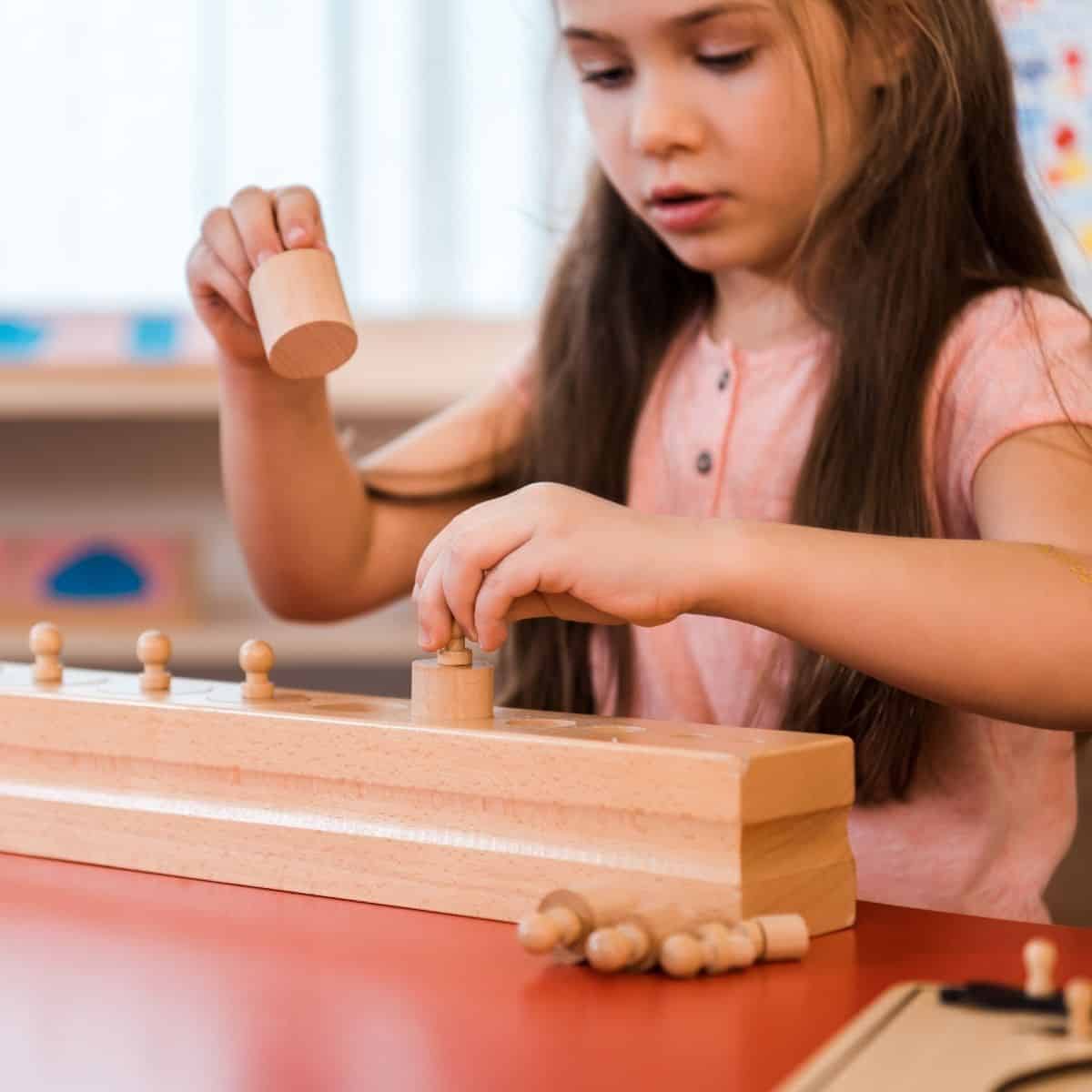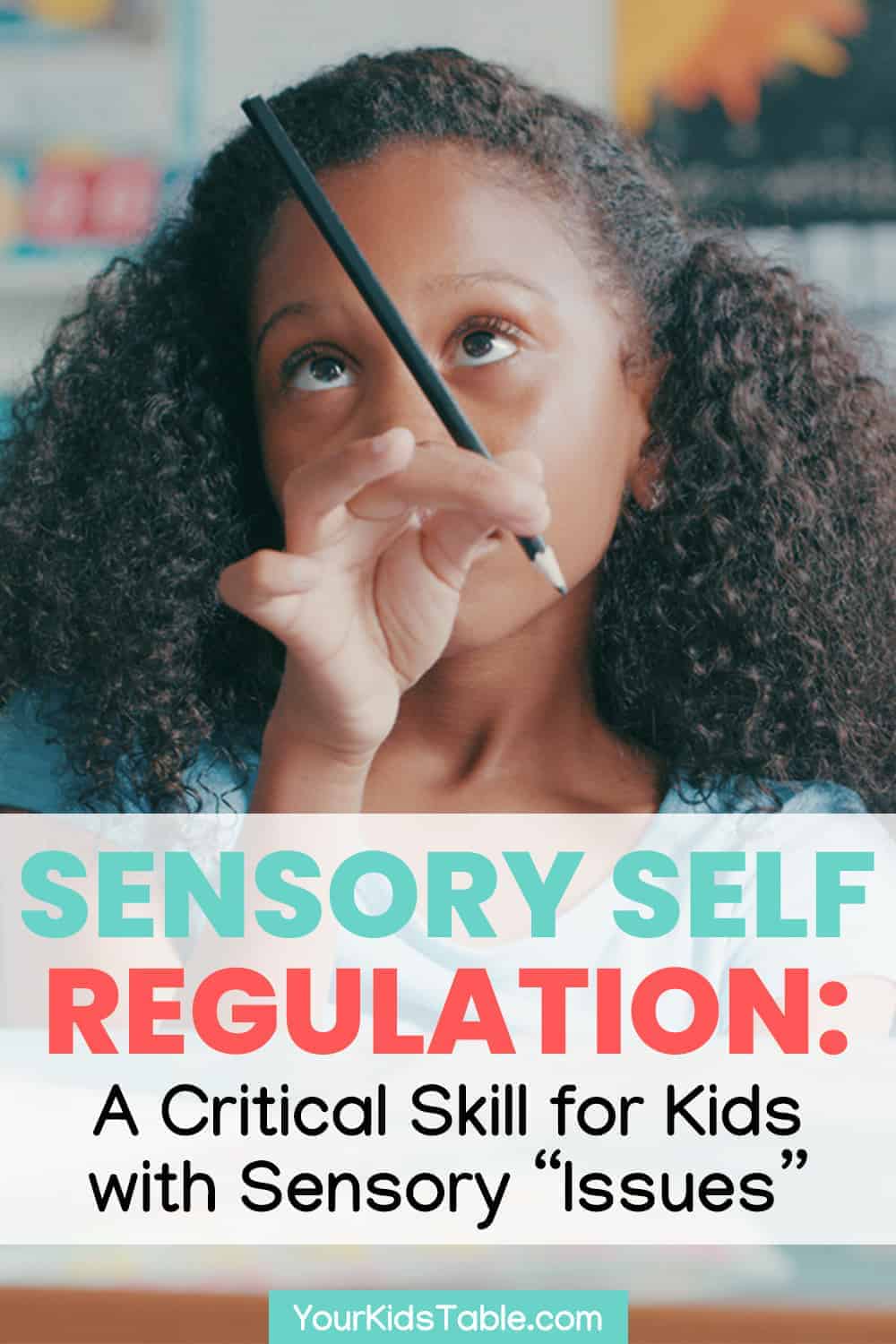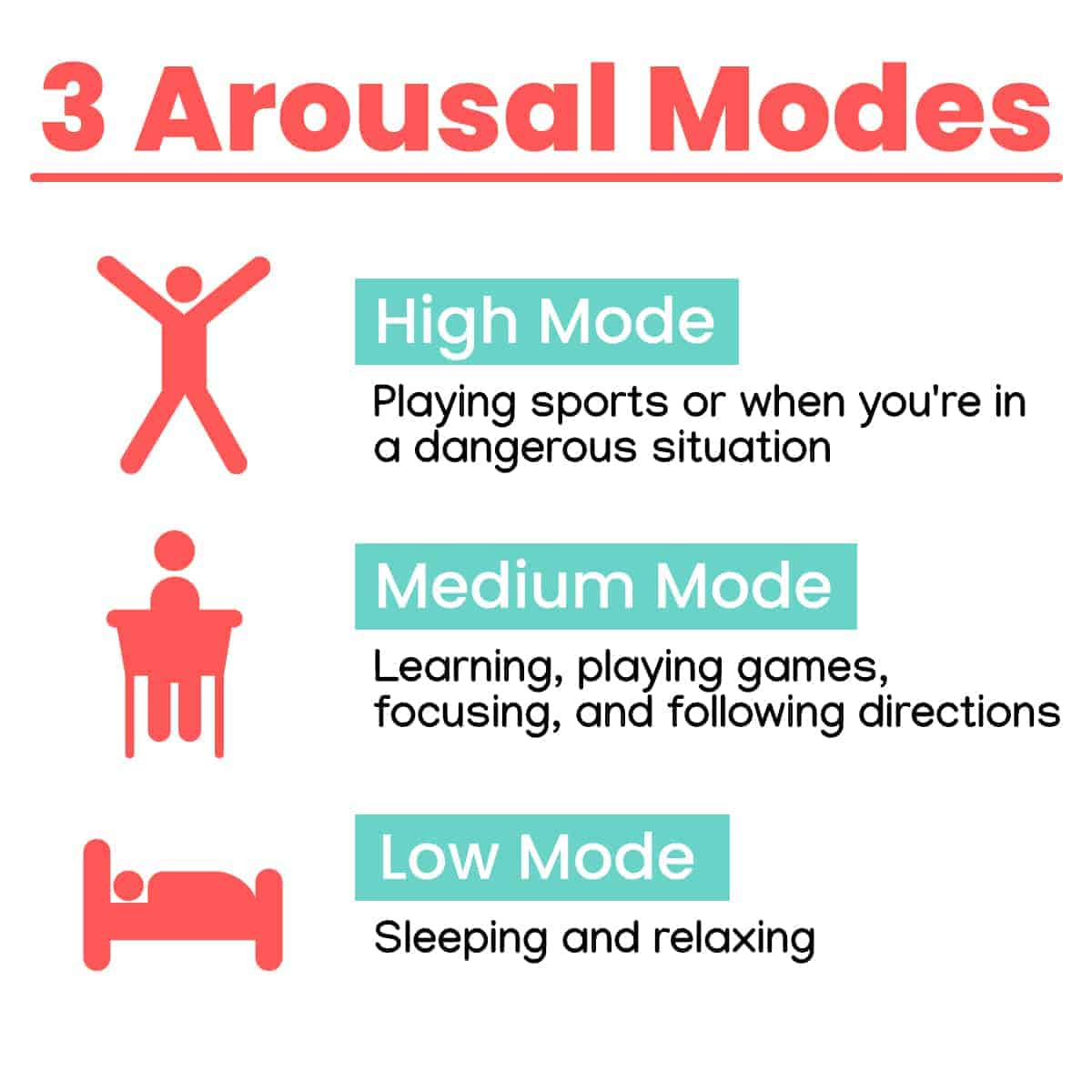Learn what sensory self regulation is, why it matters, and what sensory strategies improve self regulation skills in kids that have sensory “issues” or difficulties.
Sensory self-regulation is one of those terms that pediatric occupational therapists, like myself, often use with parents. But, what the heck does it mean??
While it might seem like OT jargon, self-regulation is an important skill that many kids with general sensory issues, autism spectrum disorders, and sensory processing disorder specifically sensory modulation disorder, struggle with.
Without self-regulation skills, sensory kids are often riding an internal roller coaster ride of arousal states (more on what that means in a minute) that they can’t help.
Sensory regulation is a huge component of sensory processing problems.
What is Sensory Self-Regulation?
Sensory self-regulation is the brain’s ability to calm down or become more alert depending on the environment, task at hand, and social situation.
Self-regulation is a process that happens so quickly for most of us that we rarely give it much thought.
Let me give you a good example…
Let’s say you’re exhausted. One of the kids was up in the middle of the night. Your toddler has been whining all morning, and everybody is on their last clean pair of underwear.
(I’m sure this is hard to relate to.)
You need to focus so you decide to take a walk with the kids or put on some music and have a dance party or have a cup of coffee. Whatever you choose, you’re self-regulating because you’re doing something to change how tired you feel when you need some energy and focus.
The same could be true if you’re wired with too much energy. Maybe you had one too many cups of coffee and it’s your bedtime. To self-regulate, you might do some things to calm down like take a bath, read a book, have a cup of chamomile tea, or do some deep breathing.

Self-Regulation is the Ultimate Goal for ALL Kids…
The problem is sensory kids often have no idea how to do this. And, they aren’t aware that they should be calm and focused because it’s time for math class or story time at the library.
They don’t get or care that they’re full of energy at 9 pm and they have to get up at 6 am tomorrow morning. So they’ll keep bouncing, talking, crying, or running around.
They literally don’t have the skills to change what we call their arousal state or arousal level, which should develop as children move out of infancy.
When a child is a baby, the parent is often in charge of their regulation. If they’re upset, startled, or wide awake, we rock them, snuggle them, give them a pacifier to help regulate them.
Many sensory kids are stuck in a high level of arousal unable to change it on their own. They don’t know how to get their bodies into a lower state of arousal which is 100% necessary for doing things like sleeping, learning, sitting at the table for dinner, or playing a board game with a friend!
We have 3 main modes or zones of regulation:
- High mode: necessary for playing sports or when you’re in a dangerous situation
- Medium mode: necessary for learning, playing games, focusing, and following directions
- Low mode: necessary for sleeping and relaxing
Kids should be in medium mode most of the day because they have learning tasks that are necessary for their development whether they’re 2 or 12.
As a toddler, a child is learning when they build simple puzzles or practice taking turns with a ball. A five year old is learning when they write their ABC’s and play a game of duck-duck-goose. And, a 10 year old is learning when they have to figure out what the least common denominator is in math class or follow the rules playing kick ball at recess.
ALL of these tasks and many more are often difficult for sensory kids because they can’t self regulate out of a high or low mode of arousal to the middle mode where they need to be so they can focus, learn, and socialize.
They’re often blindly stuck in high mode and you see non-stop movement or meltdowns.
Some sensory kids with low registration are stuck in low mode and are constantly lethargic and unmotivated. In either case, their social skills, learning, and development can be affected.
How Can Kids Self-Regulate their Sensory System?
Self-regulation is often indirectly improved when children begin to use sensory strategies that directly match the sensory difficulty they’re having. There are A LOT of sensory activities you can do with your child, but they all won’t be helpful.
Some will even be harmful. It’s important to understand which of the 8 senses are causing sensory difficulties and if that sense is avoiding, seeking, or not registering sensory information.
This is often referred to as a sensory diet, which has nothing to do with food, but everything to with a daily diet of sensory activities. Because the word “diet” has so many negative connotations, I don’t use that term very often anymore.
To help simplify the sensory diet and make it simple to use, I created the RISE strategy. It’s 4 simple steps to match and use the right sensory activities for your child which in turn helps your child’s arousal level decrease or increase depending on which is necessary.
RISE stands for: see the Red Flag, Identify the sensory need, provide Sensory Input, Evaluate if it was effective. This is the heart of our RISE with Sensory program.
To help children begin to self-regulate on their own, there are two additional strategies that are beneficial:
#1: Sensory Integration Exercises: These are special sensory activities that directly work to improve sensory processing by rewiring the brain. Very powerful stuff. I teach you some fundamental sensory integration activities you can do at home in RISE with Sensory.
#2: Teach your child about arousal levels: Kids can understand the concept of their bodies running on high, medium, or low. Ask them what mode their body feels like it’s in most of the time. Or, when they’re struggling with certain tasks what mode it is in and how they might change it.
Continuing to use this language in conversations and helping them connect certain sensory activities to their bodies ability to calm down or speed up can teach them to directly self regulate their sensory system.
Does Sensory Self-Regulation Help Emotional Regulation?
Emotional regulation is different from self regulation, but they are closely connected. Many parents notice their child having explosive or huge emotions that seem to come out of nowhere.
Emotions are registered by the interoceptive sense, which is part of sensory processing. And, when a child works to self regulate their sensory system and even more specifically, their interoceptive sense, their emotional regulation is often positively affected as well.
How to Get Help for Sensory Self Regulation Difficulties
If your child is in occupational therapy, talk to their OT about self-regulation strategies. You can also seek out an OT evaluation, check with your insurance for coverage.
And, whether your child is in OT or not, our free workshop: 3 Expert Secrets to Calm and Focus Your Child with Specialized Sensory Activities is a great place to learn how to leverage sensory activities to regulate their child, which helps them learn to self-regulate!
Get a Spot in the Workshop HERE!!
More Tips for Self Regulation in Kids
What Parents Need to Know About Sensory Dysregulation
4 Sensory Routines to Calm and Organize Kids Through the Whole Day
7 Ways to Help Kids Sensitive to Hair Brushing!
Must-Know Executive Functioning Skills by Age & Activities To Improve It in Your Child
Alisha Grogan is a licensed occupational therapist and founder of Your Kid’s Table. She has over 17 years experience with expertise in sensory processing and feeding development in babies, toddlers, and children. Alisha also has 3 boys of her own at home. Learn more about her here.


Great article- sharing with my team!
Hi Marge! Awesome! So glad you found this post helpful and are sharing it with your team! If you’re looking for more professional resources, check out the special section on our website, here.
Best,
Kalyn